Chapter 3: Blood Vessels:
A Flawless Transportation Network
Imagine that you have installed 100 trillion houses over a wide area and that—as in our earlier analogy—you had set up a water facility among them. No doubt this task would be very laborious and difficult. But assuming that you have been successful, still you will need a very large area for the network of pipes. Would you be able to install such pipelines in miniature form in an area the size of the human body?
To pose this question another way, could you set out a network approximately 100,000 kilometers (some 60,000 miles) long, in the most appropriate manner, in such an economical way as to fit in the human body, and so the network could link to every one of our 100 trillion cells? It would be impossible! A circulatory system such as you could never produce has already been formed inside your body. It was created for you before you even entered the world, giving life to all your cells. This is one of the most important proofs that you have another perfect marvel of creation in your body. The human circulatory system possesses such a miraculous organization that it is by itself reason enough to have faith in God.
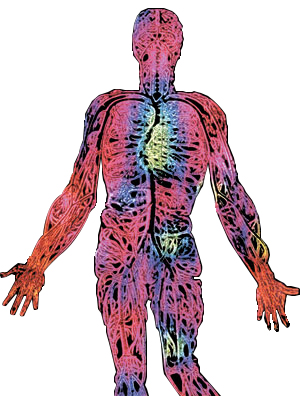 |
The heart pumps blood non-stop through a vascular network 96,600 kilometers (60,000 miles) long, the equivalent to twice the Earth's circumference at the equator.99 It is astonishing that such a network should have been installed inside the body. Some mathematical information will detail this miracle even more. The total length of the body's capillaries, some visible only under a microscope, is 60,000 kilometers (37,280 miles).100 Their total surface area is almost 8,000 square meters (3.1 square miles). In the lungs alone, there are 300 million capillaries. If were laid out, end to end, they would stretch for 2,400 kilometers (1,491 miles).101 The length of the capillaries in the brain is around 650 kilometers (403 miles). That, for example, is the distance between the cities of Boston and Washington DC, in two totally different states in the USA.102
These are just a few of the innumerable facts that prove there is no room for coincidences in the human body. Another miraculous aspect of this is that generally, humans are totally unaware of this splendid network, thousands of kilometers long, extending to 100 trillion cells. You see no trace of it when you glance in the mirror, never feel its ceaseless activity, seldom become aware of the noises your heart produces as it beats. So perfectly created is this system that barring the emergence of some defect, you spend your life quite problem-free, unaware that minor defects are repaired without your knowledge. Nobody in the world, no community, and no technology possesses the ability to produce a living network so flawless, flexible, and impressive. This work of art belongs to God, the Creator of all things, the Generous, the Lord of all the worlds.
Consider this network, which extends to 100 trillion cells, in more detail. Everywhere in your body, from eyelids to toes, from your hair roots to your eyelashes, is linked by this perfect structure. Were this network not to reach one single region or organ, it would decay. Remember that without blood, the body itself cannot breathe, and will die.
How does this impeccable distribution come about? It is important to know the details in order to appreciate the groundlessness of the claims made on the subject based on "chance." The body's circulatory system consists of three different types of blood vessels, brought together for three different purposes.
The Journey of the Small Red Blood Cell
In order to join the bloodstream, the first place that a red blood cell produced in the bone marrow will reach is the left atrium, where oxygenated blood is collected. The purpose behind the red blood cell being here is to load up with oxygen and transport it to the other cells of the body. Leaving the left atrium in order to join the circulatory system, the red blood cell first encounters a giant door. After passing through it, there is no means of going back. It has now reached a much wider chamber—the ventricle. Here there are many cells like itself, and blood exceptionally rich in oxygen. Thanks to a powerful pump in this large section, it passes through another door and enters a narrow tunnel, or artery.
The small red blood cell is now in the body's greater circulation, or systemic circulation. By means of this great circulation, our small cell has now entered a tunnel system that travels the entire body, with the exception of the lungs. The first tunnel the red blood cell enters is the aorta, the most powerful artery in the body.
Oxygen Is Distributed to the Cells
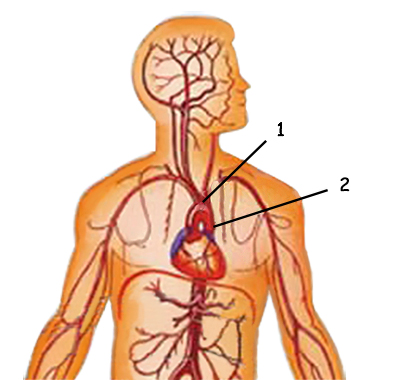 | |
1. Aortic arc | 2. Chest aorta |
The aorta leaves the heart and divides in two: The upper branch goes to the head and arms, and the lower to various subsidiary vessels and organs. When the body is at rest, the oxygen is transported to the tissues in less than 10 seconds after it is picked up from the lungs. During exercise, this period is reduced to 2 to 3 seconds. | |
The aorta is where the blood leaves the heart. It contains a rather large amount of blood and in a normal adult is about 2.5 centimeter (1 inch) wide.103 Since this artery will distribute oxygenated blood to the other arteries, it must be especially strong and resistant, because the blood transported through it is under high pressure. It also possesses a very special structure, as one would expect.
The aorta and the pulmonary artery that leave the heart consist of three layers. First, there is an outer casing consisting of fibrous connective tissue, whose presence is of the greatest importance. The elastic fibers in it provide resistance against pressure. If the arteries lacked this property, then the blood arriving from the heart under high pressure would inevitably damage, even tear them. This particular feature exhibited by God in this important artery is another manifestation of His title of "He Who creates with no previous model" (Al-Badee'). Bearing in mind that these heartbeats take place hundreds of times a day, then logically, the probability of the artery tearing or rupturing should be very high. Yet the protective system in question has eliminated that danger, ensuring that the artery can resist that pressure for a whole lifetime. This is also a reflection of the affection in which God, Who protects and observes, holds His servants.
In the middle layer of the aorta are elastic fibers composed of smooth muscles, of great importance in terms of regulating the amount of blood sent. By contracting or expanding, the muscles serve to narrow or widen the diameter of the artery. The quantity of blood going to the organ and tissues is balanced thanks to this elastic structure. The inner surface of the aortic and pulmonary arteries consists of a lining made up of a single row of flat epithelial cells.104 Thanks to this tissue, it's as if the interior surface had been polished. This smooth, slippery surface reduces friction and allows the blood to flow easily and quickly.
The aorta drawing away to the left in the form of a bow, divides in two. The section that heads upward leads to the head and arms, and the artery that branches off downward reaches the other organs by means of various sub-arteries. Under resting conditions, these arteries generally distribute oxygen to the tissues within about 10 seconds of receiving it from the lungs. When a person engages in strenuous exercise, however, the speed of the blood in the arteries increases. The red blood cells can now transport oxygen in as little as 2 or 3 seconds. They therefore, with the inspiration they receive from God, possess the ability to meet the changing needs of the body.
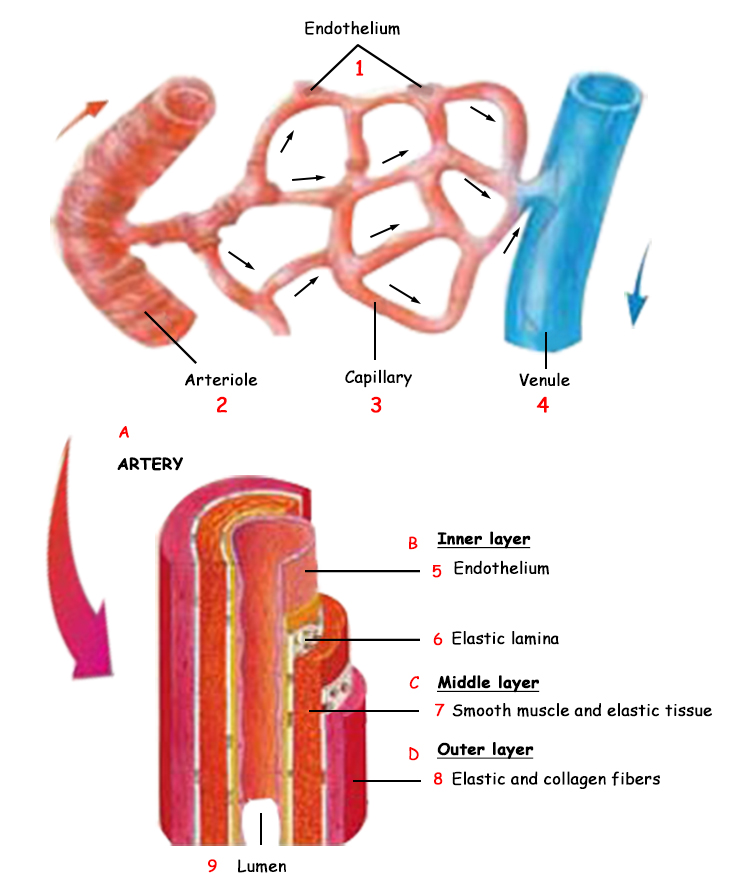 | ||
A. ARTERY B. Inner layer | 1. Endothelium | 5. Endothelium |
Elastic fibers on the outer layer of the artery provide resistance against pressure, such as the powerful heartbeat. The middle layer consists of elastic tissue and smooth muscles, which are important with regard to the regulation of the amount of blood dispatched. The flat epithelial tissue in the inner layer has a smooth, literally polished surface that permits the easy flow of blood by reducing friction. | ||
The special property mentioned above is extremely important. Thanks to their elastic muscular structure, which is capable of expanding, the arteries have a storage function that allows there always to be blood in the body. This elasticity in the arteries is also important, since their flexibility prevents the pressure from rising too high when blood is pumped through the system. At the same time, elasticity permits a constant flow of blood through the tissues by maintaining a high arterial pressure between heartbeats.105 God has created this elasticity, which is necessary in many aspects in order to maintain the body's equilibrium.
The arteries lie generally deep within the body. In some places, however—for example, in the wrist, the temples, neck, the backs of the feet and ankles—they are much closer to the surface. In these regions, the passage of blood as it strikes the arterial wall under high pressure can be felt under the skin with every heartbeat.
That the arteries are hidden deep inside the body is a precaution of the greatest importance. Thanks to this, arteries are not easily damaged. By means of this flawless order, our Lord—Who created the arteries, the blood inside them and Who regulates these at all times—has protected humans from the serious dangers we may encounter. That alone is enough reason for a person to turn to God and give thanks.
At times of injury, it is generally the veins that suffer damage. But as we shall be seeing in some detail, these do not carry high-pressure, viscous blood. During injury, therefore, the blood flowing in a heavy, dense form has the prospect of clotting easily. In the event that an artery is damaged, however, the bright, high-pressure blood is expelled very quickly. This is most dangerous since the bleeding can swiftly result in death unless immediate precautions are taken.
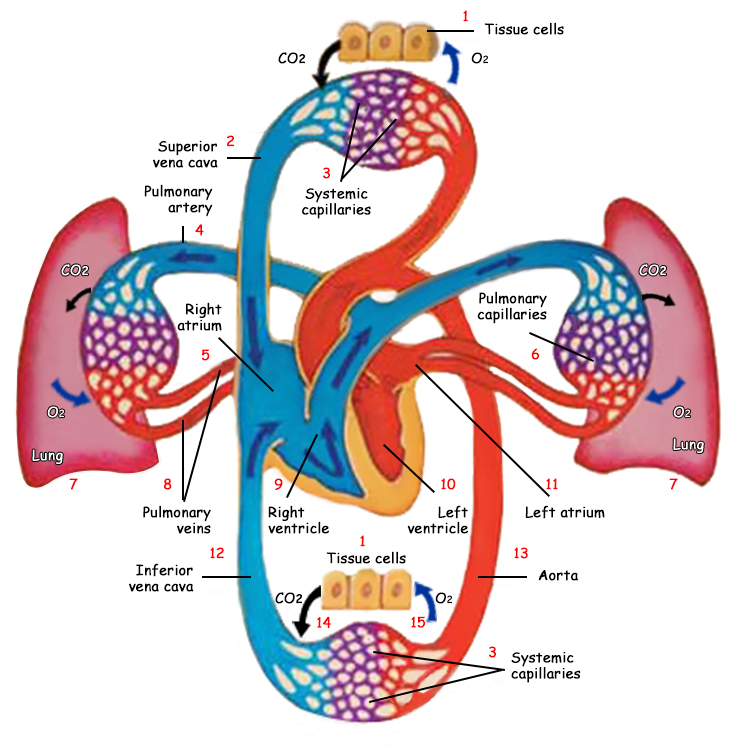 | |||
1. Tissue cells | 5. Right atrium | 9. Right ventricle | 13. Aorta |
A red blood cell begins its journey in the left atrium. It then travels through the whole body, from the toes to the brain, by way of blood vessels and capillaries measured in mere millimeters. It deposits oxygen at the tissues and takes up carbon dioxide, enabling it to be given off by the lungs when it completes its journey. | |||
Arterioles: Arterial Connection Points
In order for blood to be distributed from the arteries, those arteries have to subdivide. For that reason, the main arteries 2.5 centimeters (1 inch) in diameter subdivide until they assume the form of capillaries just a few microns in diameter. At this point, our red blood cells continue their journey down these dividing passages. Because of the high blood pressure in the arteries, the erythrocyte can travel a long distance inside the body in a matter of seconds, its objective being to reach the capillaries and deposit the oxygen it is carrying.
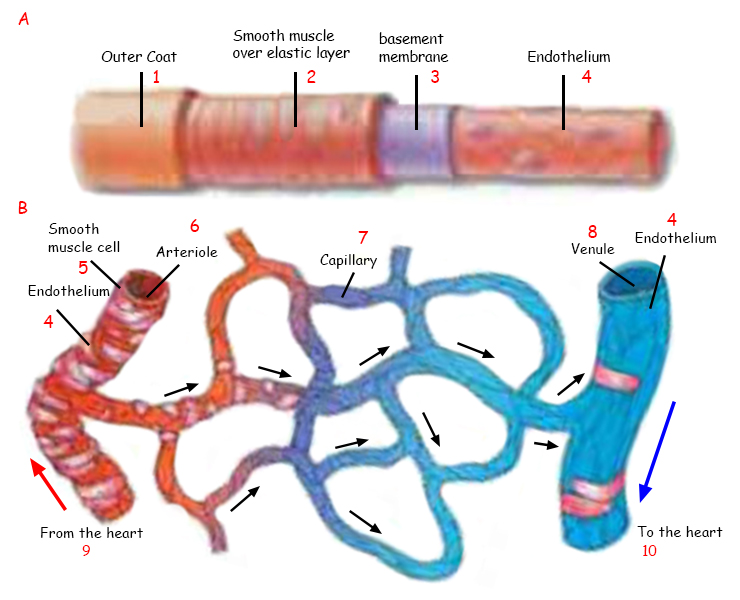 | ||
A. Details of the capillary network | 1. Outer coat | 6. Arteriole |
The arteries divide into arterioles before leading into capillaries. They serve as control valves in the sending of blood to the capillaries. They therefore possess very special features: Thanks to their strong muscular walls, they control the blood flowing into the capillaries and prevent them from being damaged. | ||
Arterioles are the smallest branches in the arterial system—the arteries' final state before they finally lead into capillaries. These serve as control valves in sending blood to the capillaries. Arterioles possess a most important powerful muscular system capable of completely closing themselves or else widening severalfold, mainly to alter the blood flow reaching the capillaries, and to be able to send the tissues as much oxygen and nutrients as they need. They prevent these very delicate vessels from being damaged by the sudden entry of high-pressure blood. The resistance of the arterioles accounts for approximately half of the resistance in the entire systemic circulation, which is greater than anywhere else in the circulation.106
The flow of blood to all tissues is controlled almost entirely by small arteries and arterioles. But even the smallest vessels are able to affect that flow. They may cause the flow to stop completely, besides regulating its speed, because they are able to determine to which cells they will give special treatment. In order to be able to carry out this delicate determination, the blood leaves the small arteries and enters the arterioles, just a few millimeters long and 8 to 50 microns in diameter. Each arteriole divides into branches so as to be able to supply 10 to 100 capillaries.107
The small red blood cell, having entered an arteriole, then branches off to the tissue it will subsequently feed. It needs to enter a capillary in order to supply oxygen and nutrients. It will pass one of the arterioles—the control valves, in other words—that will act as a guide for it. The time has now come for it to do its job.
 |
Intelligent Capillaries Thinner Than a Human Hair
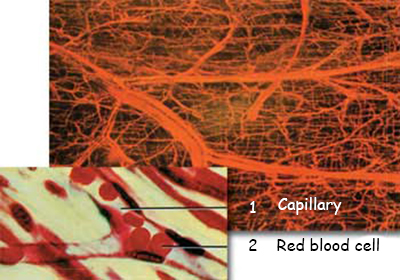 | |
1. Capillary | 2. Red blood cell |
The capillaries are so narrow that they refuse to permit many substances to pass through. Even tiny red blood cells can pass through only in single file or by changing their shape. | |
If you live in an average-size home, it will have a floor area of approximately 150 square meters (1,615 square feet). The total surface area of the 10 billion capillary vessels in your body is 3.5 times greater than that—about 500 square meters, or 5,382 square feet.108 While making this comparison, recall that the largest capillary is just 9 microns across. (Nine microns is 9/1000th of a millimeter.) Indeed, some capillaries are so tiny that they are visible only under a microscope. This broad network, installed so as to reach every point in the body, is a most splendid one that should remind people again and again of the greatness of God.
The artery that enters any organ divides and thins six to eight times before becoming an arteriole, the capillaries' control valve. Subsequently, the arteriole itself will branch two or three times, reducing its diameter to just 9 microns, and will continue on as a capillary. Some of these capillaries are so small that they cannot let even some large blood cells pass through them. Even red blood cells pass through such capillaries in single file, or else by distorting their shape.
The blood proceeding along the arteries at 1.5 kilometers an hour (0.93 miles per hour) slows down by a thousandth of that rate when it enters the capillaries. Every region of the body has been penetrated by an extraordinarily wide ranging network of capillaries. The capillaries in just one single person could stretch from one end of the USA to the other.109 This incomparable mechanism is brought into being to nourish all the cells in the body. In fact, a cell can be no further than 20 to 30 microns from a capillary—a distance of 0.02 millimeters (0.0007874 inch), which is sufficient to grasp the scale of this magnificent network that visits 100 trillion cells.
What is The Transport Mechanısm of Capillaries? | |
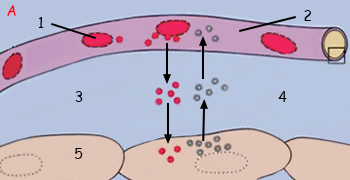 | |
1. Blood cell | 3. Interstitial fluid |
A. An exchange of substances between the blood and the tissue cells takes place by means of the interstitial fluid. | |
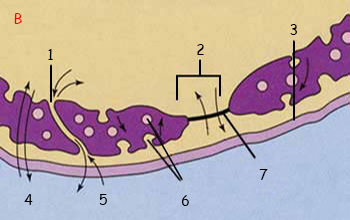 | |
1. Intercellular cleft | 5. Diffusion through intercellular cleft |
B. This diagram shows the four different means of transport through the endothelial cell wall. | |
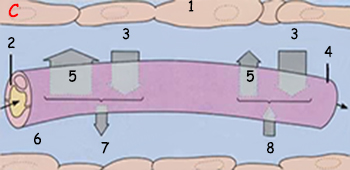 | |
1. Tissue cells | 5. Blood pressure |
C. Flow of fluid across the capillary walls generally depend on the difference between blood pressure and osmotic pressure at different points of the capillary bed. Blood pressure establishes an outward force. Osmotic pressure, on the other hand, draws the fluid back. As a result, fluid is expelled from the capillary by means of clefts at the arterial end, and is taken in the blood again in the venous end. | |
A person can comprehend the magnificence of the system confronting him only when he stops to consider these features in detail. Otherwise, the account will be no different from what can be found in any physiology textbook. How this marvel of engineering, in thicknesses of just a few microns, can reach every cell in the body is an extraordinary creation. Your hands, face, feet, arms and every square millimeter of your body all possess a perfect network of countless capillaries. Even more astonishingly, all these networks are interconnected, each one being fed from a single source. Add in the fact that just one of your fingers possesses hundreds of capillaries, and you can better understand the scale of this marvel. This perfection that you view came into existence solely through God commanding it to Be! and God, the Lord of the worlds, Lord of the heavens and Earth, has the power to create even greater perfections. Indeed, God reveals this truth in the Qur'an:
The creation of the heavens and Earth is far greater than the creation of humanity. But most of humanity do not know it. (Surah Ghafir: 57)
In these tiny vessels, there are still more miracles created by God. Capillaries have a much greater importance than is indicated by their size. These vessels ensure the exchange of fluid, nutrients, hormones and other substances between blood and the tissues. In line with that responsibility, the walls of the capillaries are exceedingly thin, and possess special structures that permit small molecules to pass through them. In short, such vital functions as nourishing the tissues and providing them with oxygen, while collecting their wastes, all take place thanks to these capillaries.
The capillary walls are 0.5 microns in thickness. In these walls, there are a number of gates through which substances are exchanged. All essential substances for the cells must pass through these gates. However, some plasma proteins are too large to be able to pass through. This means that only appropriate substances can cross into the tissues, and that other molecules must stay in the blood and continue on their way. At the same time, these proteins prevent blood plasma from leaking into the tissues. Since there is no more than a very small amount of leakage of fluid and proteins into the tissues, no situation arises that might damage the exact balance in the body.110
Fat-soluble substances, on the other hand, need not pass through the capillary gates. They can directly diffuse across the capillary membrane. This is most important, because this facilitated passage permits oxygen and carbon dioxide to be transmitted rapidly and in large quantities. Therefore, these gasses are transported at a speed several times greater than substances such as sodium and glucose, which are not liquid-soluble. This is in direct proportion to the tissues' needs for these gasses, which can pass the gates only when the need arises.
These intelligent pipes, just a few microns in size and consisting of connective tissue and muscle tissue, control the flow of blood according to the need of the individual tissue cells. This control is a very definite blessing from God. Through this important precaution blood does not flow through the capillaries constantly, but is sporadic. If the tissue requires a large quantity of blood, then the capillary expands under the effect of a superior control mechanism and extends the period during which blood flows. In this way is provided a greater flow of blood, and thus of oxygen and nutrients.111
Having entered, our small red blood cell continues through this narrow zone with difficulty, and in stops and starts. Thanks to the hemoglobin molecule inside it, it is ready to deposit the oxygen it has carried en route. It approaches every cell in need of oxygen, and deposits the oxygen molecules in a very careful way so that they will harm neither itself nor the cell. In return it picks up the carbon dioxide that the cell needs removed. Now ready for its return journey, it has picked up another load and must return to its destination—the heart, the first center where it picked up its load.
The work these capillaries do is clearly precautionary; something that only an intelligent entity such as a human can perform. However, the truly noteworthy events taking place in the body are unknown to the great majority of people. Most reading these lines will be learning for the first time about these bodily phenomena, such as those in the capillaries, and will be newly aware of the precautionary measures taken. Once again, you can see that it is not the human beings who take these precautions.
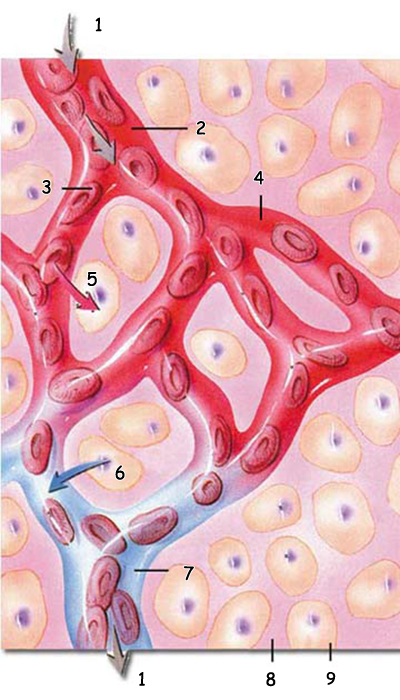 |
1. Blood flow 6. Wastes
A red blood cell approaches the tissue cell in need of oxygen and deposits oxygen in it. With the carbon dioxide it has taken from the cell, its charge is now different and it now sets out through the veins toward the heart. |
God creates the most perfect works on Earth. It is sufficient to see them in order to comprehend the source of intelligence manifested in them. God reveals the following about those people who can see and those who cannot in His verses:
Say: "Who is the Lord of the heavens and the Earth?" Say: "God." Say: "So why have you taken protectors apart from Him who possess no power to help or harm themselves?" Say: "Are the blind and seeing equal? Or are darkness and light the same? Or have they assigned partners to God who create as He creates, so that all creating seems the same to them?" Say: "God is the Creator of everything. He is the One, the All-Conquering." (Surat ar-Ra'd: 16)
The blind and the seeing are not the same. Nor are those who believe and do right actions the same as evildoers. What little heed they pay! (Surah Ghafir: 58)
 |
"Why indeed should I not worship Him Who brought me into being, Him to Whom you will be returned? Am I to take as deities instead of Him those whose intercession, if the All-Merciful desires harm for me, will not help me at all and cannot save me?" (Surah Ya Sin: 22-23) |
The Veins: The Return Journey in the Giant Circulatory Network
While the red blood cell loads with carbon dioxide and gets ready to return, the tunnel around it widens increasingly as it moves away from the capillaries. A great many erythrocytes and other cells have joined it, and they move through the increasingly widening tunnel like a great army. By now, the blood pressure moving them has fallen. Subsequently, they will need to progress more slowly. Their bright red color imparted by the oxygen has almost entirely disappeared. It is now a darker color, purplish, because the load they are carrying is carbon dioxide.
These giant tunnels through which the red blood cells proceed on their way are veins, the vessels by which the cells traveling through the body return home. The widest veins are as thick as a pencil.112 The cells in the bloodstream carry the carbon dioxide and other wastes they've collected from the tissues to the heart for expulsion from the body or to be re-used.
The heart meets the two large veins. One is the superior vena cava, which comes from the head, arms and upper body, and the other, the inferior vena cava, which comes from the lower body. Carbon dioxide in these veins returning to the heart will be expelled by means of the lungs, and the blood cells' endless journey will start again from the beginning, with oxygen molecules. The small red blood cell will perform this function many times, 1,000 times in the course of a single day, without ever growing tired and resting.113
Just like the arteries, the veins are very large blood vessels. But their muscular walls are thinner than the arteries'. The main reason is that the blood no longer flows under such high pressure on its return journey. Even though the veins have no need to be able to withstand pressure, there is a most important reason for their being muscular. Thanks to their muscular walls, the veins can store large amounts of blood by enlarging and constricting. This blood they store is kept ready for use whenever needed, anywhere in the circulation.114
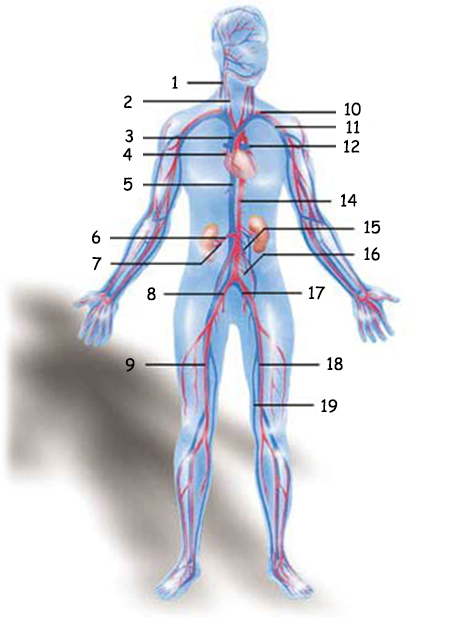 |
1. Jugular vein
10. Great saphenous vein
Veins are able to carry three times more blood than do the arteries and capillaries, thanks to their special structure. |
Here it will be useful to provide some important information: 84% of the entire blood of the body is in the systemic circulation, with 64% on its return journey in the veins. The proportion of blood in the arteries is just 15%. The capillaries extending for 60,000 kilometers (37,280 miles) in the body contain only 5% of the blood. The heart contains 7% of the blood, and the pulmonary vessels 9%.115 The most striking aspect of this is the high level of blood in the veins, and the low level in the capillaries. The veins carry three times as much blood in systemic circulation as the arteries and capillaries. The veins carry so much blood, as stated earlier, thanks to their blood-storage duty.
Vein structure | |
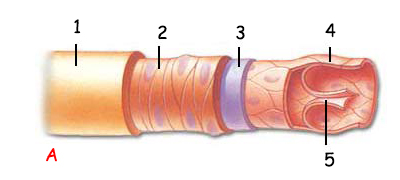 | |
A. Vein structure | 3. Basement membrane |
Unlike the arteries, the veins are not subjected to strong blood pressure, and therefore have different structures. Thanks to their muscular walls, the veins can store large quantities of blood by enlarging and constricting. Thus blood stored in the veins is available for immediate use in emergencies. | |
The level of blood in the capillaries, on the other hand, is rather low compared to their work. There is a constantly controlled flow of materials to these fine blood vessels.
When the body begins to lose blood, and when blood pressure begins to fall, pressure reflexes arise in various parts of the circulation, and these send nerve signals to the veins. Receiving this information, the veins begin to constrict and, thanks to this ability, are easily able to overcome the body's blood loss. Even if 20% of the blood is lost, thanks to the special reservoir system of the veins, no problem occurs: The circulatory system continues to function as before.
Being under low pressure, it might appear difficult for blood in the veins to move through the body, especially upward toward the heart. However, this problem has been resolved with another perfect system. Every moment you move, the muscles in your body create pressure on the veins and help the blood to move. The pressure applied by your leg muscles to push blood upward is equal to the downward pull of gravity. When the veins leave the skeletal muscles after passing through very mobile regions like the legs or arms, the respiratory muscles assist them. The blood in the inferior vena cava, immediately beneath the lungs, moves with every breath we take. Therefore, the pressure set up by the chest cavity helps the blood continue on its way to the heart.
The veins have additional ways of controlling the flow of blood. The most important of these are small valves, unique to the veins, and not found in the arteries. These valves permit blood in the veins to flow in one direction only, similarly to the valves in the heart, and close again behind it, preventing the blood, moving under low pressure, from running back down again.116 There is no need for such a mechanism in the arteries, where pressure is very high and there is no possibility of the blood moving backwards. This system has been created by God in a flawless and detailed manner, and each type of blood vessel possesses the ideal system to transmit blood. This imposing mechanism in the veins is without doubt the work of God, "Who created and molded" (Surat al-A'la: 2) and is "the Creator, the Maker, the Giver of Form" (Surat al-Hashr: 24). He created human beings and made the innumerable complex mechanisms in the human body as proof of this creation.
Despite this difference in pressure, the amount of blood flowing from the arteries and the veins is always the same. The body needs such equilibrium, or else blood will accumulate in certain sites in the body. Because of lower pressure in the veins, the blood doesn't flow fast as in the arteries. In other words, it seems impossible for the veins to carry as much blood as the arteries; yet that is not actually the case. Since the veins' lumen diameter is wider than arteries', they can carry large amounts of blood. In other words, blood flows rapidly in the arteries, and in large quantities in the wider veins. The level of blood heading out and returning to the heart is thus perfectly balanced.117
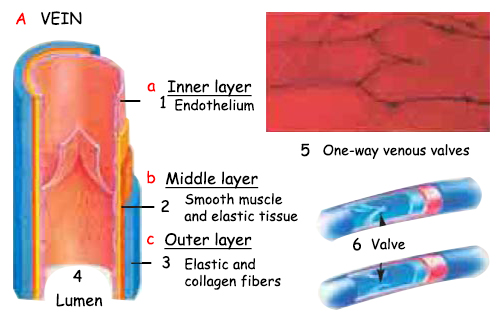 | ||
A. VEIN | a. Inner layer | 1. Endothelium |
As a requirement of the work the veins perform in our bodies, they possess a different structure. Valves in the veins can open and close as deoxygenated blood is carried back to the heart. Thanks to them, blood is prevented from flowing backwards and always forwarded to the heart. How do the veins know that they need to possess such valves? This example once again shows us the superior knowledge and creation of our Lord, Who created us so perfectly. | ||
The concept of balances within the body may be unfamiliar to most people, because they spend their lives with no great difficulties. Yet there are innumerable balances in the body that need to be maintained and should never be impaired in any way. The blood's circulation is just one example. Many factors might have a negative effect on this equilibrium, but the system for keeping this balance is so incomparable that the amount of blood leaving the heart and the blood returning to it are always the same.
If this balance is disrupted, blood sent out to the extremities cannot return, but will accumulate in various places in the body. That will cause edemas and injuries from burst veins, if not gangrene. Since insufficient blood returns to the heart, the amount of oxygenated blood will be very low, and clean, oxygenated blood sent by the heart will be insufficient for nourishing the body. If this imbalance persists, the organs will begin to die.
Considering the importance of the equal amount of blood coming and going, you can clearly see that this is a perfect balance specially created by God, in His name as The Giver of Life (Al-Muhee). As we examine everything in detail, we become better acquainted with God, our Creator, and can comprehend His might. It shows us that we owe God for everything. For all the blessings created by God, a person must praise Him constantly and live for His approval. The unbelievers seek for alternative explanations for the signs of creation in living things, and with those explanations, think that they can make others deny the existence of God and His creation. However, God is the Superior, the Powerful, the Mighty and the Unconquerable. This fact is stated in a verse:
God has written, "I will be victorious, I and My messengers." God is Most Strong, Almighty. (Surat al-Mujadala: 21)
After its journey in the veins, blood returns to the heart to be transported to the lungs, where the transported carbon dioxide will be dropped off. The only veins in the body that carry oxygen-rich blood are the pulmonary veins. When we examine the "pulmonary circulation" in the body, you will better understand why the pulmonary veins assume such a different responsibility.
Blood Oxygenation in the Lungs and Pulmonary Circulation
 | ||
1. CO2 | 3. Lungs | 5. Aorta |
The circulatory system carries oxygen from the lungs to the tissues. Carbon dioxide, on the other hand, is transported from the tissues to the lungs. Glucose is absorbed by the intestines and stored in the liver temporarily in the form of glycogen. Later it is sent to the tissues. This flawless division of labor once again reveals the flawlessness in God's creations. | ||
Since the red blood cell began its journey and traveled through the entire body, 40 seconds have passed. It is now back at the heart where it has begun, now traveling in deoxygenated blood. However, it is essential to clean this blood. Therefore, the red blood cell takes its place in the right atrium in order to begin this new journey, known as the pulmonary circulation.
This time, everything will occur at the right side of the heart. With the opening of the valve on the right atrium, the cell and its companions move into the right ventricle. Once it has, the right ventricle's valve closes, and it cannot turn back. It stays in the right ventricle for a short instant, until the second valve opens the way to the lungs. The cell's second journey has begun—shorter than the first, however, which is why it is also known as the small circulation.
From the right ventricle, the blood reaches the pulmonary artery, which divides into the right and left pulmonary branches. These two vessels lead to the lungs, further dividing at the membranes of the alveoli—air sacs where oxygen and carbon dioxide are exchanged—into various capillaries. The newly oxygenated blood is carried by the pulmonary vein to the left atrium of the heart, where its journey began. This is how oxygenated blood is carried by a vein for a change.
The air enters the lungs by way of the bronchi, which are divided many times until they end in the alveoli. In the lungs there are some 300 million alveoli, all of their membranes covered with capillaries for the exchange of oxygen and carbon dioxide. It is not hard to estimate the diameter of the capillaries in the lungs. The surface area of the alveoli is 70 square meters (750 square feet), which is about the size of a racquetball court. With their walls just 10 millionths of an inch thick, the capillaries and alveoli fulfill functions of vital importance to us.118
This exchange of gasses that takes place in the lungs is truly miraculous. Each minute, the lungs send 56 x 1021 (the number 56 followed by 21 zeros) oxygen atoms to cells all through the body.119 All you have to do is to breathe. With the amount of the air we inhale throughout the day, this magnificent exchange of gasses in our lungs takes place at enormous speed. Following this exchange, our small red blood cell, now loaded with oxygen, has returned to the beginning of its journey in the left atrium to carry oxygen to the tissues. This extraordinary journey, which has been explained in general terms, has lasted less than a minute.
 | |||
A. CAPILLARY 1. Oxygenated blood | 3. Oxygen transported into the blood | 8. Blood cells | 13. Basement membrane fibers |
The barrier between the air in the alveoli and the blood in the capillaries is a total of 4 micrometers thick—equivalent to half the diameter of a red blood cell. The extreme fineness of this barrier shows how very swift and effective the two-way exchange of gasses across this barrier is. | |||
Recall that if the capillaries were slightly further from the alveoli, then that vital exchange would be impossible. The fact that they are located right beside the alveoli is yet another example of the perfect and amazing design we have encountered throughout this book. Not even a human using his reason, able to plan and engineer, possesses the ability to make such a flawless design, which reveals its presence clearly at all points inside the body. This is the work of a Great and Mighty Power. God introduces Himself to us by these important proofs of creation. It is easy for anyone of understanding to see the works of God. God has revealed this important truth in the Qur'an:
God is the Creator of everything and He is Guardian over everything. The keys of the heavens and Earth belong to Him. It is those who reject God's signs who are the losers. (Surat az-Zumar: 62-63)
 |
The Blood-Flow Control Mechanism
 |
Weighing the advantages and disadvantages of something to be done, and taking the relevant precautionary measures, is an ability peculiar to reasoning human beings. However, looking at the human circulatory system, we can see that some of the excellent organizations in the body are more intelligent than human beings. They have the huge responsibility of sustaining human life! Therefore they need to continue their journey without any breaks, never making a mistake, and most important of all, by foreseeing all situations and conditions.
There is considerable evidence that the mechanisms in the body are intelligent. As mentioned before, the needs in the body are identified.This is carried out in a superior mechanism, by God's inspiration. The heart, blood vessels and the cells carry out an extremely conscious organization. According to this, the heart pumps a specific volume of blood, the red blood cells distribute the oxygen they carry to tissue cells and, most importantly, the blood vessels direct its flow to its destinations.
While you are sleeping or resting, your heart doesn't need to pump as much blood. When you sleep, the heart pumps only the blood needed to keep you alive—of course a valuable saving. When you get out of bed and begin walking, your heart rate increases. Before you meet any difficulty, the message is transmitted that your body is moving and the muscles need more blood. When you begin running, your heart's pumping speed and volume increase by 6 to 7 times.
The body is very thrifty in this regard. The same quantities of blood are not delivered to every point in the body at every moment. Blood is directed to your stomach when you eat, in your lungs and your muscles when you swim, and in your brain when you concentrate on reading—because the cells mostly in need of nutrients and oxygen are in those areas.
Thrift is not valid for those times only. Under normal conditions, the body makes no special effort to nourish the muscles, which comprise 30-40% of the body's weight. The amount of blood going to the muscles during periods of rest is astonishingly low. When you begin to work your muscles, however, your metabolic activity increases 50 times, and the blood flow to your muscles increases 20 to 25 times.120 This is really an astonishing change, but during exercise, muscles need this extreme flow of blood. If they were to require such a large quantity under normal conditions, then it would be impossible for the heart to keep up. The intelligent controllers of the body prefer to divert existing blood in more essential and important areas, such as the brain.
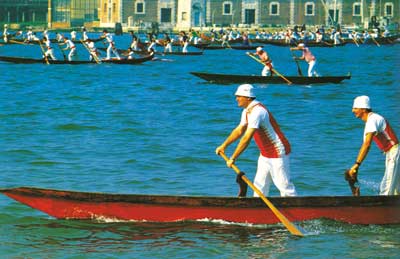 |
When we engage in sports, our muscles need 20 to 25 times more blood than normal. If our muscles needed that much blood even under normal conditions, the heart would be unable to match that extreme tempo. Yet our Lord, Who has created all things with a measure, has created our hearts and muscles to be compatible with one another. |
The brain is in constant need of nourishment and oxygen, since everything that takes place in the body, and all the organs are under its control. Interestingly, the heart, blood vessels and blood cells seem to be aware of this vital fact. For that reason, the flow of blood to the brain always continues. Every minute, the arteries need to transport approximately 1 liter of blood to the brain. During bleeding, any decreased blood level in the body is communicated to the brain by the nerves. The blood vessels in the brain enlarge or constrict in order to adjust themselves to this emergency situation. Blood vessels in less important organs, aware of the situation, halt their own flows in order to protect the brain function. Thus, once again we find the intelligence that shows itself in every point in the body.
The blood flow of every tissue in the body is controlled in such a way for meeting its requirements—neither more nor less. For example, the flow of blood to a tissue needing a lot of oxygen is as much as it needs, or maybe a little more, but never greater than that. This impeccable control keeps the heart's activity to a minimum, while never allowing the tissues to be nourished insufficiently. This amazing control keeps the heart's workload at minimum level.121 The blood vessels open their pathways—in other words, enlarge—only for the tissues in need, and paths to other tissues less in need of blood constrict. Here lies the importance of the perfect muscular structure of the blood vessels.
What if there were no such control system, so that every tissue and organ were nourished with the same quantity of blood? The heart would have to pump more blood than it does now,122 and such a tempo would soon exhaust it. When climbing a mountain or engaging in strenuous sporting activity, for instance, your body needs a higher level of oxygen. You begin breathing very rapidly, and your heart beats very fast, to meet your body's rising need for oxygen. All your tissues being nourished with the same amount of blood would lead you to experience a similar situation 24 hours a day.
The blood vessels are created specially to achieve this perfect control. In cases of emergency, they know to take the appropriate and intelligent life-saving precautions. For example, a cold environment that causes body temperature to fall can be dangerous; the brain may suffer. Thanks to this superior ability of the blood vessels, however, a human being can withstand the cold. Upon encountering cold air, blood vessels in the fingers and toes immediately constrict as the first precautionary measure. Since vessels in the hands and feet are near the surface, they can cause the blood to cool. Their constriction prevents blood from cooling too much and the cooled blood from cooling down the heart and brain.
When met with extremely cold weather, your body's blood vessels may even sacrifice a finger or a toe to save you from freezing to death, and completely halt the flow of blood to that area. At the same time, the brain sends a message causing the muscles to shiver, causing the body temperature to rise.123 When you go out in snowy weather, you will immediately feel these effects of your body taking these precautions.
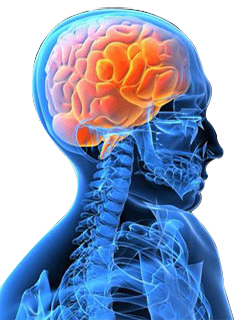 |
In the event of any kind of accident, the brain—as the main center in the body—is one of the organs most in need of protection. The blood vessels in our bodies act in the knowledge of the brain's priority. If the amount of blood reaching the brain declines, both the brain's own blood vessels and other blood vessels take precautionary measures. The brain blood vessels enlarge or constrict, and other blood vessels elsewhere in the body slow the flow of blood through them in order to divert more to this important organ. |
The constriction and enlargement of the blood vessels is the result of an order given by the brain. By means of various nerves and hormones, it sends messages to the relevant blood vessels and it is accordingly determined which tissue needs what. For example, when you feel very hot or when you are embarrassed, signals from your nerves reach the muscle cells within the walls of the arterioles. As a result of their relaxation, the blood flow increases and your face flushes.124
In this regard, the capillaries behave independently. They permit the flow of blood in the light of requirements, halting it when necessary. For example, the flow of blood to your small intestine accelerates after you eat. But when you are resting, the blood flow to your muscles is cut down. In fact, you do not have enough blood to fill all the capillaries in your body. If all the capillaries were open at the same time, there wouldn't be sufficient blood for the brain, and you would soon faint. If that situation were prolonged, it could result by brain damage.125
The capillaries' ability to control the flow of blood directly is a very important property in terms of keeping the body temperature stable. The capillaries halting the flow of blood in cold weather, especially in regions close to the skin, helps limit loss of heat.126
Outside heat also is as crucial as cold in maintaining internal body temperature. When it is a hot day, the blood vessels in the body use the exact opposite method: Blood vessels close to the skin dilate. The blood rushes to areas close to the surface, and your face thus turns a reddish color. The heat in the blood warms your skin, and its heat is dissipated into the air. In this way, the body's internal temperature remains at an even, normal level.
In view of these many magnificent precautions, every rational person can see a magnificent order and complete perfection that surpasses human wisdom. Anyone who seeks an explanation for all this will realize the absolute existence and dominion of God.
These perfections, which have been described since the start, show that the mighty presence of God is everywhere, and to help us be aware of that fact, His splendid works exist in our own bodies as well. People who fail—or refuse—to see these manifest truths will realize the extent of their error in the Hereafter. For ignoring the countless proofs God has shown them, and even for seeking other explanations for what they are shown, the response may be a very great one. God has prepared an eternal life in Hell for those who knowingly deny Him.
All who use their intellect must consider the existence of the Hereafter and seriously fear the torments of Hell. In one verse, God reveals the situation of unbelievers in the Hereafter:
And [when] the True Promise is very close, the eyes of those who disbelieved will be transfixed: "Alas for us! We were unmindful of this! No, rather we were definitely wrongdoers." (Surat al-Anbiya': 97)
 |
He cast firmly embedded mountains on the earth so it would not move under you, and rivers and pathways so that hopefully you would be guided and landmarks. And they are guided by the sears. Is He Who creates like him who does not create? So will you not pay heed? (Surat an-Nahl: 15-17) |
Footnotes
99 http://hes.ucf.k12.pa.us/gclaypo/circulatorysys.html
100 John Farndon, Angela Koo, Human Body, Factfinder, Dempsey Parr, 1999, p. 53.
101 http://people.a2000.nl/aalan/sirlar/vuc.html
102 http://www.nature.com/cgi-taf/DynaPage.taf?%20file=/nbt/journal/v17/n8/full/nbt0899_753.html
103 David Burnie, Dorling Kindersley The Concise Encyclopedia of the Human Body, Dorling Kindersley; 1st ed., 1995, p. 90
104 http://efnt1.fedu.metu.edu.tr/SCE51998/binzat/damar.htm, "Kan damarlari" ("Blood Vessels")
105 Textbook of Medical Physiology, 7th Edition, p. 220.
110 Textbook of Medical Physiology, 7th Edition, pp. 220, 221.
111 Textbook of Medical Physiology, 7th Edition, Nobel Tip Kitapevi, Çapa, Istanbul, p. 507
112 The Heart - Our Circulatory System, p. 15.
114 Textbook of Medical Physiology, 7th Edition, p. 221.
116 The Heart - Our Circulatory System, p. 15.
117 Body Atlas - The Human Pump, Video by Pioneer Production for The Learning Channel, Discovery Communications, Inc., 1994.
118 The Incredible Machine, p. 119.
119 "The Circulatory System," The Encyclopedia of Health, p. 43.
120 Textbook of Medical Physiology, 7th Edition, Istanbul: Nobel Tip Kitapevi, p. 334.
123 http://www.newton.dep.anl.gov/askasci/bio99/bio99317.htm, "Ask A Scientist"
124 Biology Today, Sandra S. Gottfried, Mosby - Year Book, Inc., 1993, p. 202.
- Introduction
- Chapter 1: Blood: The Incomparable Liquid of Life (1/10)
- Chapter 1: Blood: The Incomparable Liquid of Life (2/10)
- Chapter 1: Blood: The Incomparable Liquid of Life (3/10)
- Chapter 1: Blood: The Incomparable Liquid of Life (4/10)
- Chapter 1: Blood: The Incomparable Liquid of Life (5/10)
- Chapter 1: Blood: The Incomparable Liquid of Life (6/10)
- Chapter 1: Blood: The Incomparable Liquid of Life (7/10)
- Chapter 1: Blood: The Incomparable Liquid of Life (8/10)
- Chapter 1: Blood: The Incomparable Liquid of Life (9/10)
- Chapter 1: Blood: The Incomparable Liquid of Life (10/10)
- Chapter 2: The Heart the Most Efficient Machine in the World
- Chapter 3: Blood Vessels: A Flawless Transportation Network
- Chapter 4: Evolution's Impasse in the Face of the Circulatory System's Perfection
